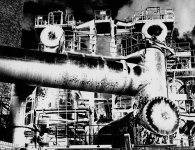lightmuncher
New member
- Dec 18, 2022
- 288
- 303
- Edit my images
- Yes
This is an image I took on a 5x4 negative back at the Reading College 1976. My friend and I walked around Reading with a huge 5x4 camera! I considered this technique would be better if it were an image of an industrial site. This was a gas site, that fed Reading's general populace. This manipulation is done whilst developing the negative. A 5x4 negative is developed separately which makes this technique the only way. Whilst some way into development, you do something that goes against the grain (don't you just love puns 🫣 ). Near the end of the development you take the negative out of the developer and shine it to the light. This process has to be done quick enough to allow the technique to work. And that is how you get this technique to do its strange Macky lines around the railings and other parts of the industrial scene.
If interested I have a few other images to share and explain the details of its processes.

If interested I have a few other images to share and explain the details of its processes.

Last edited: